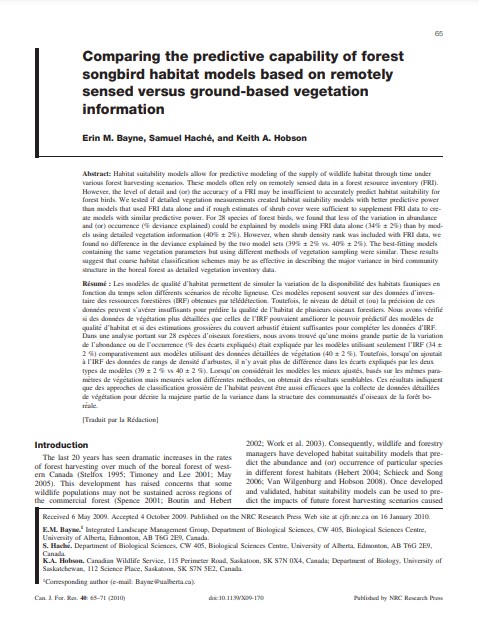Comparing the predictive capability of forest songbird habitat models based on remotely sensed versus ground-based vegetation information
Bosque Modelo:
Prince Albert
Temática:
Desarrollo humano
Tipo de documento:
Artículo científico
Resumen
Habitat suitability models allow for predictive modeling of the supply of wildlife habitat through time under various forest harvesting scenarios. These models often rely on remotely sensed data in a forest resource inventory (FRI). However, the level of detail and (or) the accuracy of a FRI may be insufficient to accurately predict habitat suitability for forest birds. We tested if detailed vegetation measurements created habitat suitability models with better predictive power than models that used FRI data alone and if rough estimates of shrub cover were sufficient to supplement FRI data to create models with similar predictive power. For 28 species of forest birds, we found that less of the variation in abundance and (or) occurrence (% deviance explained) could be explained by models using FRI data alone (34% ± 2%) than by models using detailed vegetation information (40% ± 2%). However, when shrub density rank was included with FRI data, we found no difference in the deviance explained by the two model sets (39% ± 2% vs. 40% ± 2%). The best-fitting models containing the same vegetation parameters but using different methods of vegetation sampling were similar. These results suggest that coarse habitat classification schemes may be as effective in describing the major variance in bird community structure in the boreal forest as detailed vegetation inventory data.
Información Bibliográfica
Autor:
Bayne, E.M., Haché, S., & Hobson, K.A.
Revista:
Canadian Journal of Forest Research
Año:
2010
N°:
1
País :
Canadá
Páginas:
65 - 71
Volumen:
40
Idioma:
Ingles
Palabras claves
Boreal forest, birds, impacts





